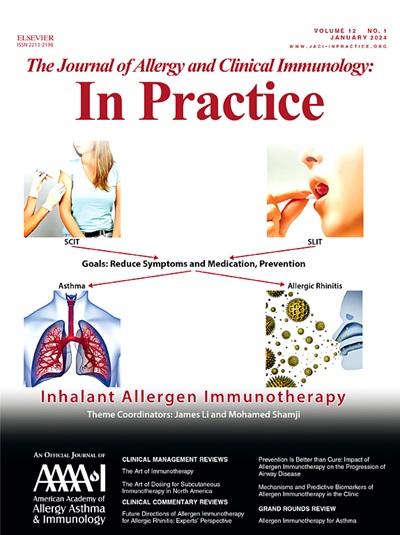小儿食物蛋白性小肠结肠炎综合征对鸡蛋致敏的临床意义。
IF 6.6
1区 医学
Q1 ALLERGY
Journal of Allergy and Clinical Immunology-In Practice
Pub Date : 2025-09-01
DOI:10.1016/j.jaip.2025.05.055
引用次数: 0
摘要
背景:鸡蛋是一种常见的ige介导的食物过敏原,是一种越来越常见的食物蛋白诱导的小肠结肠炎综合征(FPIES)的触发因素。非典型FPIES被定义为可检测的IgE食品导致FPIES。目的:评估鸡蛋FPIES患者的临床特征、自然病史、烤蛋耐受性和基于过敏致敏状态的FPIES挑战结果。方法:这项回顾性、双中心队列研究检查了由过敏症专科医生诊断为卵细胞异体畸形的儿童。我们回顾了反应特征、特应史、对鸡蛋的过敏致敏、烤鸡蛋耐受性和食物重新引入结果的图表。结果:153例FPIES患者中,124例接受了鸡蛋过敏试验,56例(36.6%)患者对鸡蛋过敏。皮肤试验和食物重新引入根据实践和患者的偏好而有所不同。48例引入烤鸡蛋的患者中有30例(62.5%)在中位20.5个月(IQR 13.25-33)的避免后耐受。包括那些在展示时耐受烤鸡蛋的人,22.9%的人在未烤之前加入了烤鸡蛋。致敏不延迟耐受性,但与重新引入时立即过敏的高风险有关。在致敏患者中,ige介导的症状在重新引入时很明显,但在非致敏和未检测的患者中不存在。从FPIES到IgE食物过敏的总表型转换率至少为9.2%。在致敏患者中,ige介导的其他食物过敏更为常见。结论:我们的数据表明,检测对鸡蛋的过敏敏感性可能有助于对未来有ige介导症状风险的FPIES患者进行分层。未来的前瞻性研究应评估FPIES患者皮肤试验的最佳时机和预测价值,以及在蛋类FPIES患者中引入烤鸡蛋的效用。本文章由计算机程序翻译,如有差异,请以英文原文为准。
Clinical Significance of Egg Sensitization in Pediatric Food Protein–Induced Enterocolitis Syndrome to Hen’s Egg
Background
Hen’s egg, a common IgE-mediated food allergen, is an increasingly common food protein–induced enterocolitis syndrome (FPIES) trigger. Atypical FPIES is defined as detectable IgE to the food causing FPIES.
Objective
To evaluate clinical characteristics, natural history, baked egg tolerance, and FPIES challenge outcomes based on allergic sensitization status in patients with egg FPIES.
Methods
This retrospective, dual-center cohort study examined children with the diagnosis of egg FPIES by an allergist. We reviewed charts for reaction characteristics, atopic history, allergic sensitization to egg, baked egg tolerance, and food reintroduction outcomes.
Results
Of 153 patients with FPIES, 124 underwent egg allergy testing and 56 (36.6%) were sensitized to egg. Skin testing and food reintroduction varied based on practice and patient preferences. Of 48 patients who introduced baked egg, 30 (62.5%) tolerated it after a median of 20.5 months (interquartile range, 13.25-33 months) of avoidance. Including those tolerating baked egg at presentation, 22.9% incorporated baked before unbaked egg. Sensitization did not delay tolerance but was linked to a higher risk of immediate hypersensitivity during reintroduction. IgE-mediated symptoms were evident during reintroductions in sensitized patients but were absent in non-sensitized and untested patients. The overall phenotype switch rate from FPIES to IgE food allergy was at least 9.2%. Concomitant IgE-mediated food allergy to other foods was more common among sensitized patients.
Conclusions
Our data suggest that testing for allergic sensitization to egg may help stratify patients with FPIES at risk for future IgE-mediated symptoms. Future prospective studies should evaluate the optimal timing and predictive value of skin testing in patients with FPIES and the utility of introducing baked egg in patients with egg FPIES.
求助全文
通过发布文献求助,成功后即可免费获取论文全文。
去求助
来源期刊

Journal of Allergy and Clinical Immunology-In Practice
ALLERGYIMMUNOLOGY-IMMUNOLOGY
CiteScore
11.10
自引率
9.60%
发文量
683
审稿时长
50 days
期刊介绍:
JACI: In Practice is an official publication of the American Academy of Allergy, Asthma & Immunology (AAAAI). It is a companion title to The Journal of Allergy and Clinical Immunology, and it aims to provide timely clinical papers, case reports, and management recommendations to clinical allergists and other physicians dealing with allergic and immunologic diseases in their practice. The mission of JACI: In Practice is to offer valid and impactful information that supports evidence-based clinical decisions in the diagnosis and management of asthma, allergies, immunologic conditions, and related diseases.
This journal publishes articles on various conditions treated by allergist-immunologists, including food allergy, respiratory disorders (such as asthma, rhinitis, nasal polyps, sinusitis, cough, ABPA, and hypersensitivity pneumonitis), drug allergy, insect sting allergy, anaphylaxis, dermatologic disorders (such as atopic dermatitis, contact dermatitis, urticaria, angioedema, and HAE), immunodeficiency, autoinflammatory syndromes, eosinophilic disorders, and mast cell disorders.
The focus of the journal is on providing cutting-edge clinical information that practitioners can use in their everyday practice or to acquire new knowledge and skills for the benefit of their patients. However, mechanistic or translational studies without immediate or near future clinical relevance, as well as animal studies, are not within the scope of the journal.
 求助内容:
求助内容: 应助结果提醒方式:
应助结果提醒方式:


